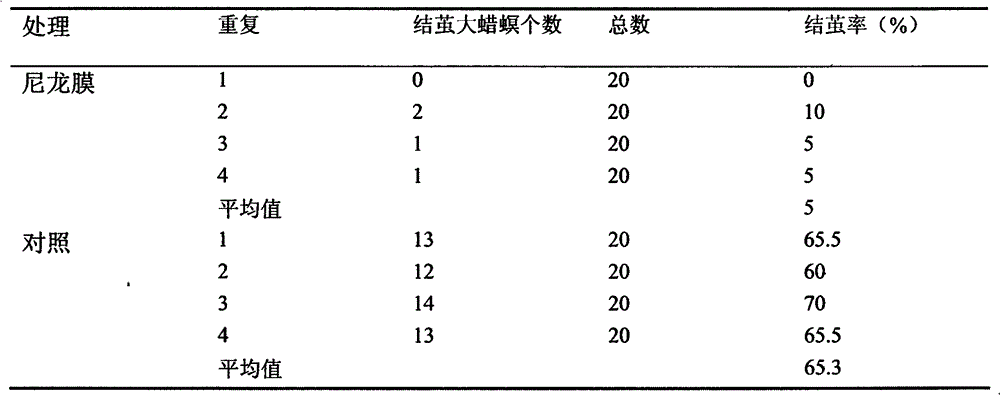Entomopathogenic nematodes insect corpse agent
A technology for entomopathogenic nematodes and insect carcasses, applied in the direction of insecticides, biocides, animal repellents, etc., can solve the problems of entomopathogenic nematodes not being resistant to drying, limiting the field application of entomopathogenic nematodes, and unstable field control effects , to achieve the effect of increasing the killing rate, reducing cost input, and avoiding insect cocooning
- Summary
- Abstract
- Description
- Claims
- Application Information
AI Technical Summary
Problems solved by technology
Method used
Image
Examples
Embodiment 1
[0020] Embodiment 1. Entomopathogenic nematode cadaveric agent is used for preventing and treating field underground pest-leek leek maggot (Shandong Shouguang)
[0021] Experiments were arranged in a greenhouse leek field in Shouguang, Shandong. Select 5 leek plots (150m2 / plot) to apply insecticide, with an average of 1 insecticide per square meter. The specific application method is to dig a 3cm-5cm hole between the two rows of leeks, put the insect corpse agent into the hole and bury it with soil. Water once within 7 days after applying the insecticide, and the nematodes in the insecticide can be released into the soil. In addition, 5 adjacent leek plots (150m2 / plot) were selected from each farmer, and the chemical pesticide phoxim was used to control leek maggots according to the farmers' habits, and the dosage was 4.5kg / mu, as a control.
[0022] It can be clearly observed that the leeks in the treatment group are growing well, and there are not many green and yellow lea...
Embodiment 2
[0025] Embodiment 2. Entomopathogenic nematode cadaver agent is used for preventing and treating underground pests in the field-leek leek maggot (Tianjin Baodi)
[0026] Experiments were set up in open-field leek fields in Baodi, Tianjin. Select 4 leek plots (15m2 / plot) to apply insecticide, with an average of 1 insecticide per square meter. The specific application method is to dig a 3cm-5cm hole between the two rows of leeks, put the insect corpse agent into the hole and bury it with soil. Water once within 7 days after applying the insecticide, and the nematodes in the insecticide can be released into the soil. In addition, 5 adjacent leek plots (15m2 / plot) were selected, and the chemical pesticide phoxim was used to control leek maggots according to farmers' habits, and the dosage was 4.5kg / mu, as a control (CK).
[0027] It can be clearly observed that the leeks in the treatment group are growing well, while the leaves of the leeks in the chemical pesticide group are wi...
Embodiment 3
[0030] Embodiment 3. Entomopathogenic nematode cadaver agent is directly used in the prevention and treatment of underground pests in the field - grubs (Taizhou, Jiangsu)
[0031] Collect grubs and soil (the general term for larvae of the family Coleoptera Scarabidae) in the vegetable plots for planting shallots and taro in Hailing Agricultural Park, Taizhou City, Jiangsu Province, and bring them back indoors. Put the soil in two cut-off mineral water bottles, fill with 100 grams of soil, and 3-4 grubs. In the experiment, the entomopathogenic nematode nematodes treatment and the control were set, and the entomopathogenic nematode treatment was put in at a level of 1 nematode per bottle. After 4 days, the investigation results showed that after the entomopathogenic nematodes were treated with the dead agent, grubs could be effectively controlled (Table 4).
[0032] Table 4 The killing effect of entomopathogenic nematode cadavers on grubs (Taizhou, Jiangsu)
[0033]
PUM
 Login to View More
Login to View More Abstract
Description
Claims
Application Information
 Login to View More
Login to View More - Generate Ideas
- Intellectual Property
- Life Sciences
- Materials
- Tech Scout
- Unparalleled Data Quality
- Higher Quality Content
- 60% Fewer Hallucinations
Browse by: Latest US Patents, China's latest patents, Technical Efficacy Thesaurus, Application Domain, Technology Topic, Popular Technical Reports.
© 2025 PatSnap. All rights reserved.Legal|Privacy policy|Modern Slavery Act Transparency Statement|Sitemap|About US| Contact US: help@patsnap.com



